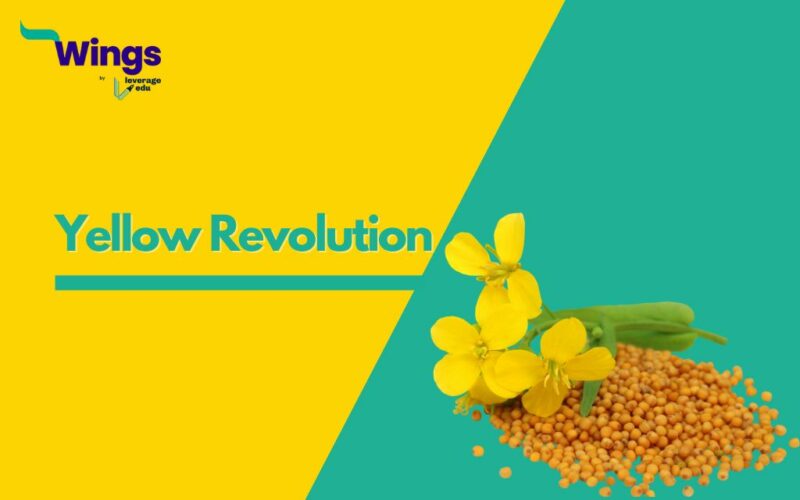In India, Yellow Revolution was launched in 1987 to increase the production of edible oilseeds in the country. It aimed to achieve self-sufficiency in edible oils, a crucial staple in Indian cuisine. This agriculture initaive led to a substantial surge in the cultivation of oilseed crops such as sunflower, mustard, and soyabean. Through technological advancements, improved farming techniques, and government support, Indai reduced its dependency on expensive edidele oil imports. This in turn, increased the nation’s food security and agricultural sustainability. Therefore, the revolution stands as a testament to India’s ability to tackle crucial agricultural challenges and increase its self-reliance.
This Blog Includes:
About Yellow Revolution
This revolution was launched in the year 1986, and kept going on till 1987 for the production of edible oil. Mustards, sesame seeds, etc. were produced to achieve self-reliance, and this came to be known as the Yellow Revolution. The father of the yellow revolution is Sam Pitroda. The oilseeds which come under this revolution include groundnut, mustard, soybean, safflower, sesame, sunflower, niger, linseed, and castor.
Yellow Revolution in India
India came up with the Oil Technological Mission in 1986 to ensure that there is success for this particular movement. The Yellow revolution implanted the hybrid mustard and sesame seeds which increased the production of edible oil significantly.
- It was also because of the use of improved technology for oil production in the country.
- The Revolution gave rise to a new era with blooming sunflowers in the state of Punjab.
- The country was brimming with opportunities. Not just that, it also helped in controlling the socio-economic differences in India.
- There was a significant change as the oil production was merely 12 million tonnes when the revolution started, which turned to 24 million tonnes in 10 years.
- With the use of the hybrid seed, there were many other measures taken to improve production.
- There was an increase in agricultural land usage to about 26 million hectares. Along with that, there was extensive use of modern technological inputs.
Features of the Yellow Revolution
The yellow revolution came up with many benefits for the farmers. They were given facilities like fertilizers and pesticides for the crops, as well as irrigation etc. Other facilities included the transportation facility and storage. This was required to make the revolution successful.
- Boards such as the National Dairy Board were given many important responsibilities to enhance the production of oilseed.
- The NDB took the responsibility to increase the production of groundnut oil in Gujarat.
- Just like that, another board was the National Oilseeds and Vegetable Oils Development Board. They had the power to enhance the production of oilseeds in other areas as well.
- Oilseeds Production Thrust came in India to boost the production of the four oilseeds, mainly, mustard, groundnut, soybean, and sunflower.
- The country had potential and many new areas for development for the farmers. There were about 3000 oilseed societies being put up with the hard work of 13 lakh farmers and 25 hectares of land that was used in India.
- In the last ten years, India might have achieved self-sufficiency in oil production, but the output of India has been way less than what the citizens are consuming.
- India has started to import oilseeds from Malaysia, Argentina, Brazil, etc. to make sure that everyone meets their demand.
Yellow Revolution at Present
At this time, the cultivable area cannot be expanded more. There is a continuous shortage of edible oils that would suggest that the Oilseeds Technology Mission and growing oil palms have had a little impact.
- It is very difficult to increase production because there are several constraints with these crops. They are much more prone to pests and diseases.
- The area has poor environments which lead to unhealthy crops.
- To boost the output, there have been many tactics used by the farmers, like to grow high-yielding cereals to earn higher profits and use improved technology.

Credit: Indian Trade Portal
Also Read
- Golden Revolution
- Grey Revolution
- Black Revolution in India
- Pink Revolution in India
- Silver Revolution in India
- Green Revolution
- Blue Revolution
- White Revolution
FAQs
This revolution aims to increase the production of oilseeds in Indai. It was introduced in India in the financial year 1986-1987.
In India, the White Revolution contributed to a decline in business fraud. In addition, it made India the world’s top producer of milk and milk products and contributed to the eradication of poverty.
Sam Pitroda launched this revolution in India in 1986.
Follow Leverage Edu to explore other topics related to school education and boost your general knowledge!!

 One app for all your study abroad needs
One app for all your study abroad needs




















 45,000+ students realised their study abroad dream with us. Take the first step today.
45,000+ students realised their study abroad dream with us. Take the first step today.

